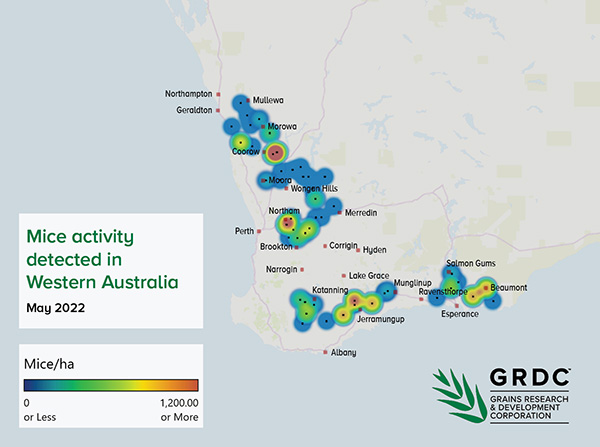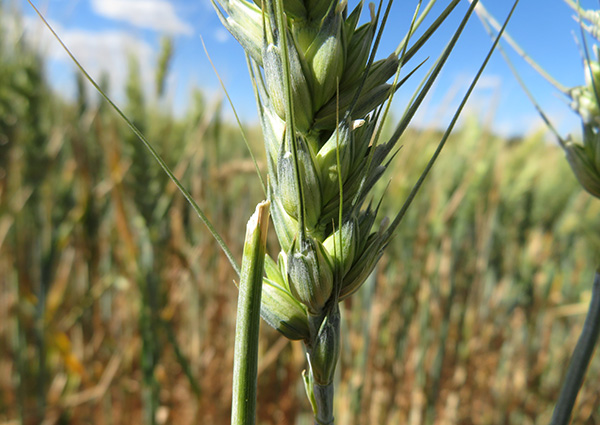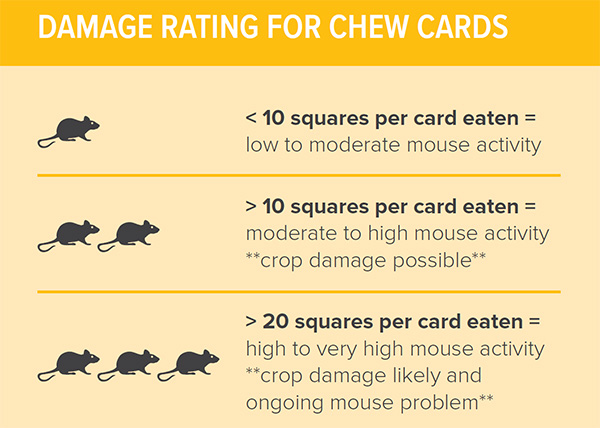
Growers across the WA grain belt are encouraged to actively and frequently monitor for mouse activity, with the recent detection of significant mouse damage to crops in Merredin and surrounds.
At a 27 June field walk arranged by Merredin and Districts Farm Improvement Group (MADFIG) and Nutrien Ag Solutions Merredin, Grains Research and Development Corporation (GRDC) representatives spoke with growers who reported holes in crops the size of utes, due to mouse damage.
Some growers in this region had not actively monitored their crops before or during seeding and were unaware of the level of risk from mouse activity.
Increased mouse activity in WA was anticipated this year due to the volume of grain left behind in paddocks after a record breaking 2021/22 harvest.
With the Bureau of Meteorology (BOM) website predicting warmer, drier conditions for WA in July, it could be a perfect storm for further extensive mouse damage in the region, as milder weather contributes to more active mouse breeding.
Steve Henry, leading mouse expert and researcher officer at Australia's national science agency, CSIRO, said that mouse numbers can build rapidly under the right conditions, leading to crop damage throughout the growing season.
"Mice can do damage at all phases of the crop, so if they're taking whole plants out when the crop's being sown, there is a related loss of yield when the crop is harvested. The key message now is to be vigilant in the late winter/early spring and be prepared to bait if you see signs of mouse activity," Mr Henry said.
Early detection and integrated management across the farm is crucial for reducing the risk of mouse impacts. Once mouse numbers are very high, it is very difficult to reduce damage and control strategies can be costly.
Surveillance and extension
GRDC has invested in additional surveillance and extension activities to alert WA growers and advisers of the presence of mouse outbreaks across the state throughout the 2022 season and extend information on effective management tactics.
A GRDC investment, led by Farmanco Management Consultants, was developed in response to feedback from GRDC's 2021 National Grower Network forums, which showed better mouse management was a priority for WA growers, who were heavily impacted by mouse damage last year.
May 2022 data from the investment shows mouse activity hotspots across all five port zones, with particularly high levels of activity around Coorow, Northam, Jerramungup and Beaumont.

GRDC Crop Protection Manager – West Georgia Megirian said that growers in these regions need to be especially vigilant over the coming months to avoid mouse infestations and widespread damage to grain crops.
"Adding more surveillance sites across the state, alongside the surveillance conducted by the Great Northern Rural Services in the Geraldton Port Zone and Ravensthorpe Agricultural Initiative Network (RAIN) in the Ravensthorpe area, has given us an indication of mouse populations in the WA grainbelt," Ms Megirian said.
"This should provide growers and industry information on potential risk of crop damage in their areas from mice at sowing and throughout the growing season," Miss Megirian says.
"However, it is still vital that growers monitor their paddocks to determine if they have a mouse issue and determine whether baiting may be required."
GRDC partnered with CSIRO to run "Mouse Roadshows" across WA in late March, visiting 21 locations across 4 days, with more than 245 growers in attendance.
Monitoring techniques
Crop damage
Accurate monitoring and early spring management are key to reducing the risk of mouse damage in developing winter crops. Growers are encouraged to complete regular checks for signs of active burrows or crop damage.
"In cereals this may be chewing at the node or stem, which causes the head to fall over or from a distance can look like frost damage," Mr Henry said.
"In canola and legume crops, growers should be inspecting flowers and pods for damage. At the first sign of crop damage, growers need to be prepared to bait, preferably with 50g/kg zinc phosphide spread at 1kg/ha.
"The best chance of success is to bait before milky stage or before pod development. Mice may not eat baits if there are lots of high-quality seeds or pods available."
Mr Henry says controlling mouse populations during late winter and early spring would effectively reduce the number of mice when breeding started in September.
Wheat


Canola

Chew cards
There are simple in-paddock monitoring techniques such as mouse chew cards that can be used when conditions indicate there is a risk of increasing mouse numbers. Mice build up locally within paddocks and can travel around 100m to forage for food.
Mouse chew cards are set out overnight and the proportion of the card that has been chewed by mice is recorded when it is collected the following day. This method is most reliable when alternative food is scarce and particularly handy in bulky crops where active mouse holes may be difficult to find under the canopy
How to use chew cards:
- Make chew cards (10 x 10 cm) using standard printer/ photocopy paper, with a 1 cm printed grid. A template is available from the GRDC website. Pre-soak the cards in canola and/or linseed oil (for about 10–15 minutes) and ensure you have enough fasteners; bent wire pegs are the best.
- Select a few paddocks that are representative of the farm.
- Place the chew cards approximately 30 m in from the edge of the paddock. Peg each chew card to the ground in a line of 10 cards spaced at 1 card every 10 m. Follow the furrows to make it easier to find the cards again the next morning.
- While walking through the paddock, look for signs of fresh mouse activity or damage.
- Retrieve the chew cards the following morning and assess for evidence of mouse damage by averaging the damage across the 10 cards.

Baiting
Currently, zinc phosphide (ZnP) is the only rodenticide registered for in-crop use (consult the label for instructions).
Zinc phosphide baits can be laid through aerial or ground application. Baiting at the time of sowing is most effective for protecting recently sown crops but baiting is also effective for controlling mouse damage during vegetative growth, flowering and seedset.
Baiting tips
- Always adhere to label instructions when baiting, and be aware of withholding periods.
- Bait on the ground is more likely to be taken before mice climb plants to eat developing seed heads.
- Talk to bait suppliers and ask for 50g/kg zinc phosphide bait to ensure best chance of success. Be aware that demand for bait is currently high.
- Control weeds and grasses along fence lines and crop margins before seedset by spraying or slashing.
- Do not bait ahead of a significant forecast rain event. Ideally bait should be applied where there is a forecast for at least three to four dry days.
- Put mouse bait out before other pest/nutrient treatments. This gives mice the chance to encounter zinc phosphide bait before they discover any other new substances in a paddock and reduces the likelihood of a sub-lethal dose being consumed and therefore bait aversion.
- Do not mix mouse bait with snail/slug bait and do not apply mouse bait with a surface application of urea. Zinc phosphide can be scraped off the surface of the treated grain when agitated with other substances.
- Co-ordinate baiting strategies with your neighbours for area-wide management and highest impact.
- Mouse-proof houses and grain/stock feed storage areas if possible.
- Seek advice and talk with other growers in your area.
Report and map regional mouse activity using the MouseAlert website.
Baiting FAQs
How long will mice continue to cause damage?
Mice can cause damage to sown seed and emerging, growing and ripening crops. Mice will continue to feed on a crop while it is a food source. Damage is most severe for about two to three weeks after crop emergence and again around seedset. However, mice will sometimes cause significant damage to tillering cereals.
How many applications of bait are required?
Monitoring is the only method of establishing if further applications of bait are required. After baiting, continue to monitor mouse activity. Rebaiting should occur more than four weeks after the first bait application to overcome bait aversion.
Tools and resources
Online resources
GRDC Mouse Management Resources
News
Maintain vigilance to protect winter crops from mice
Building mouse and insect pressure highlights importance of hygiene
CSIRO tours address mouse control in WA's regions
GRDC invests in better mouse management for WA growers ahead of increased activity
Doubling down on bait to reduce mouse numbers
Publications
Update Paper: reducing the impact of mice at critical times during the season
Tips and Tactics: Better Mouse Management
Podcast
Mouse Control in Western Australia
Videos
Grains Research Update Presentation 2022 – Mice Control – Steve Henry
Mice Control – Practical Information for Grain Growers
Mouse Management Online Workshop – Western Region 2021
This paddock practice was produced by the Grains Research and Development Corporation (GRDC) in partnership with CSIRO.






